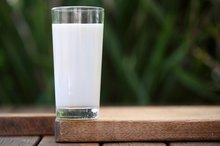What does fact checked mean?
At Healthfully, we strive to deliver objective content that is accurate and up-to-date. Our team periodically reviews articles in order to ensure content quality. The sources cited below consist of evidence from peer-reviewed journals, prominent medical organizations, academic associations, and government data.
The information contained on this site is for informational purposes only, and should not be used as a substitute for the advice of a professional health care provider. Please check with the appropriate physician regarding health questions and concerns. Although we strive to deliver accurate and up-to-date information, no guarantee to that effect is made.
Calcium Absorption and Grapefruit
Dietary calcium supports the health of your nerves, muscles, heart and bones 4. Several factors influence intestinal calcium absorption, including your vitamin D level; the activity of calcium regulatory hormones; the amount of calcium in your diet; and the chemical composition of the foods you eat. Grapefruit contains a chemical that limits the absorption of calcium from the fruit. However, grapefruit does not typically interfere with intestinal absorption of calcium from other foods.
Oxalates and Calcium Absorption
Oxalates are chemicals commonly found in high concentrations in many plants. Oxalates form strong bonds with sodium, potassium and calcium, yielding oxalate salts. These salts resist breakdown in your digestive system, making the bound calcium, sodium or potassium unavailable for absorption. Grapefruit contains a moderate amount of oxalate, making it a relatively poor source of absorbable calcium. However, the amount of oxalate in grapefruit is unlikely to disrupt intestinal calcium absorption from other foods consumed with the fruit.
- Oxalates are chemicals commonly found in high concentrations in many plants.
- However, the amount of oxalate in grapefruit is unlikely to disrupt intestinal calcium absorption from other foods consumed with the fruit.
Potentially Interfering Foods
What Is the Potassium Content in a Banana?
Learn More
Although grapefruit does not contain enough oxalate to interfere with calcium absorption from a meal, other foods do. Spinach, rhubarb, Swiss chard, turnips, rutabagas, tofu, peanut butter, sweet potatoes, tangerines, blueberries and cocoa contain high concentrations of oxalates and may significantly reduce intestinal calcium absorption. Foods that contain high concentrations of another calcium-binding chemical, phytic acid, may also reduce dietary calcium absorption. Foods with large amounts of phytic acid include dry beans, tofu, nuts, seeds and products that contain wheat bran.
- Although grapefruit does not contain enough oxalate to interfere with calcium absorption from a meal, other foods do.
Calcium in Grapefruit
Grapefruit contains many healthful nutrients, but a relatively low concentration of calcium. A cup of fresh grapefruit contains less than 1 percent of the recommended daily allowance of calcium for adults. Similarly, grapefruit juice contains less than 1 percent of the RDA for adults. In general, eating grapefruit is unlikely to significantly contribute to your daily calcium intake.
- Grapefruit contains many healthful nutrients, but a relatively low concentration of calcium.
- A cup of fresh grapefruit contains less than 1 percent of the recommended daily allowance of calcium for adults.
Meeting Your Calcium Needs
Foods With Potassium Bicarbonate
Learn More
The RDA for calcium takes into account the effects of various foods on your overall absorption of this nutrient. Therefore, if you are eating a healthful diet that includes the recommended servings from each of the food groups, you do not typically need to worry about food interactions. Examples of healthful, calcium-rich foods to incorporate into your diet include skim milk, nonfat cheese and yogurt, canned salmon and calcium-fortified cereals without added sugar. Because calcium absorption depends on an adequate level of vitamin D in your body, be sure to include vitamin D-rich foods in your diet. The RDA for calcium is 1,000 milligrams for adults through age 50. For women older than 50 and men older than age 70, the RDA for calcium is 1,200 milligrams.
- The RDA for calcium takes into account the effects of various foods on your overall absorption of this nutrient.
Related Articles
References
- Handbook of Nutrition and Food; Carolyn D. Berdanier, et al.
- Botanical Online: Oxalate Content of Foods
- USDA Nutrient Data Laboratory: USDA National Nutrient Database for Standard Reference, Release 24
- National Institutes of Health, Office of Dietary Supplements: Calcium
- Bolland, MJ, et. al. Calcium supplements with or without vitamin D and risk of cardiovascular events: reanalysis of the Women's Health Initiative limited access dataset and meta-analysis. BMJ. 2011 Apr 19;342:d2040. DOI: 10.1136/bmj.d2040
- Reid IR. The roles of calcium and vitamin D in the prevention of osteoporosis. Endocrinol Metab Clin North Am. 27: 389-398. DOI:10.1016/s0889-8529(05)70011-6
- Chen M, Pan A, Malik VS, Hu FB. Effects of dairy intake on body weight and fat: a meta-analysis of randomized controlled trials. The American Journal of Clinical Nutrition. 2012;96(4):735-747. DOI:10.3945/ajcn.112.037119
- Williams V, Rawat A, Vignesh P, Shandilya JK, Gupta A, Singh S. Fc-gamma receptor expression profile in a North-Indian cohort of pediatric-onset systemic lupus erythematosus: An observational study. Int J Rheum Dis. 2019;22(3):449-457. doi: 10.6061/clinics/2012(07)22
- Reid IR, Birstow SM, Bolland MJ. Calcium and Cardiovascular Disease. Endocrinol Metab (Seoul). 2017;32(3):339-349. doi: 10.3803/EnM.2017.32.3.339
- MedlinePlus Medical Encyclopedia, "Milk-alkali syndrome"
- Bolland MJ, Grey A, Avenell A, Gamble GD, Reid IR. Calcium supplements with or without vitamin D and risk of cardiovascular events: reanalysis of the Women’s Health Initiative limited access dataset and meta-analysis. BMJ. d2040-d2040. DOI:10.1136/bmj.d2040
- Chan Soo Shin, et. al. Endocrinol Metab (Seoul). 30(1): 27–34. DOI: 10.3803/EnM.2015.30.1.27
- Linus Pauling Institute. Calcium.
- National Institute of Health Office of Dietary Supplements. Calcium.
- Weingarten MAMA, Zalmanovici Trestioreanu A, Yaphe J. Dietary calcium supplementation for preventing colorectal cancer and adenomatous polyps. Cochrane Database of Systematic Reviews 2008, Issue 1. Art. No.: CD003548. DOI: 10.1002/14651858.CD003548.pub4
- Zemel, MB et. al. Calcium and dairy acceleration of weight and fat loss during energy restriction in obese adults. Obes Res. 2004 Apr;12(4):582-90. DOI: 10.1038/oby.2004.67
Writer Bio
Dr. St. John is a medical writer and editor with more than 15 years experience in the field. She is a former medical officer for the Centers for Disease Control and Prevention.









